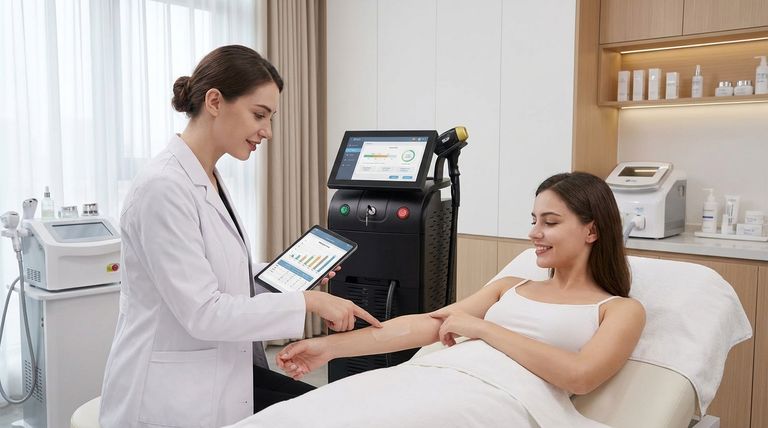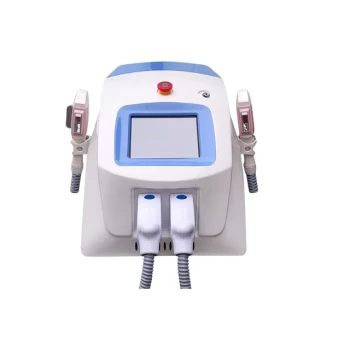To know if your laser hair removal is working, you should not look for immediate, permanent hairlessness after one session. Instead, the primary indicators are the shedding of treated hairs within one to three weeks, followed by slower, patchier regrowth where the remaining hairs are noticeably finer and lighter in color.
Laser hair removal is a process of gradual reduction, not instant elimination. True success is measured by the progressive weakening of hair follicles over a series of treatments, leading to significantly less hair that is slower to grow and easier to manage.

Immediate Indicators During Treatment
While long-term results are what matter, there are signs during and immediately after your appointment that the laser is doing its job.
The Smell and Sensation
During the session, the smell of singed hair is a positive sign. This indicates the laser's energy has been absorbed by the melanin in the hair, creating the heat necessary to damage the follicle.
Mild Redness and Swelling
Slight redness and small bumps around the hair follicles, known as perifollicular edema, are common and desirable reactions. This mild inflammation shows that the follicle has responded to the laser's heat energy.
The Key Signs of Progress Between Sessions
The most definitive evidence of success appears in the days and weeks following each treatment. This is a multi-stage process.
The Shedding Phase (1-3 Weeks Post-Treatment)
After treatment, the targeted hairs are effectively "dead" but remain in the follicle. Over the next few weeks, your skin will naturally push these hairs out in a process that can look like slow regrowth but is actually shedding. You can often gently exfoliate to help this along.
Slower Regrowth Cycles
A clear sign of success is that the time it takes for hair to reappear grows longer with each session. You will find yourself reaching for the razor far less often as the treatment plan progresses.
Patchy Hair Reduction
The treatment will create "patches" of smoothness where follicles have been successfully destroyed and no longer produce hair. These patches will grow larger and connect as you complete more sessions.
Change in Hair Texture and Color
As mentioned in the reference, any hair that does regrow will often be finer, softer, and lighter in color. This happens because even if a follicle isn't completely destroyed, it is often damaged enough to only produce a much weaker hair.
Understanding the Trade-offs and Common Misconceptions
To accurately gauge success, you must have the right expectations. "Working" doesn't always mean what people assume.
It's Hair Reduction, Not Permanent Removal
The FDA approves laser hair removal for "permanent hair reduction," not total removal. The goal is to destroy a vast majority of follicles, but it's unrealistic to expect 100% elimination forever. Maintenance sessions may be needed.
Multiple Sessions are Non-Negotiable
Hair grows in different cycles (anagen, catagen, telogen). The laser is only effective on hairs in the active growth (anagen) phase. This is why you need multiple sessions spaced weeks apart to catch all hairs in their growth phase.
Results Depend on Contrast
Laser treatment works best when there is a significant contrast between your skin color and hair color (e.g., light skin and dark hair). The laser targets pigment, so it can be less effective on very light hair and riskier on darker skin tones if not performed with the correct type of laser.
How to Assess Your Progress
Use these guidelines to evaluate the effectiveness of your treatment plan based on your primary goal.
- If your primary focus is early reassurance: Look for the shedding of coarse, dark hairs within the first few weeks after your initial session.
- If your primary focus is long-term effectiveness: Track the increasing patchiness and the growing length of the hair-free period between your appointments.
- If you are concerned the treatment isn't working: Communicate with your technician if you see no shedding or if regrowth is just as fast and dense as before your session.
Ultimately, tracking these specific changes over time is the definitive way to confirm your investment is delivering results.
Summary Table:
| Key Indicator | What to Look For | When to Expect It |
|---|---|---|
| Shedding Phase | Treated hairs fall out, often looks like slow regrowth. | 1-3 weeks post-treatment |
| Slower Regrowth | Longer intervals between needing to shave or wax. | After 2-3 sessions |
| Patchy Reduction | Smooth patches appear where hair no longer grows. | Progresses with each session |
| Finer, Lighter Hair | Regrown hairs are softer, thinner, and less noticeable. | With subsequent treatments |
Achieve Confident, Lasting Results with BELIS
Seeing the right signs of progress is key to a successful laser hair removal journey. For clinics and premium beauty salons, using professional-grade equipment is essential for delivering safe, effective, and predictable results that keep clients satisfied.
BELIS specializes in professional medical aesthetic equipment, designed to provide superior performance for permanent hair reduction. Our advanced laser systems ensure precise targeting and comfort for a wide range of skin tones, helping you build trust and grow your business.
Ready to enhance your service offerings? Contact our experts today to discover how BELIS equipment can become a cornerstone of your success.
Visual Guide

Related Products
- Clinic Diode Laser Hair Removal Machine with SHR and Trilaser Technology
- Trilaser Diode Hair Removal Machine for Beauty Clinic Use
- Diode Tri Laser Hair Removal Machine for Clinic Use
- Diode Laser SHR Trilaser Hair Removal Machine for Clinic Use
- Clinic Use IPL SHR ND YAG Laser Hair Removal RF Skin Tightening Machine
People Also Ask
- Which is safer, diode or IPL? Discover the Safer Choice for Hair Removal
- What is the No 1 laser hair removal machine? Find the Best Device for Your Skin & Hair
- Which is more effective, diode or IPL? The Definitive Answer for Permanent Hair Reduction
- What is better, an IPL or a diode laser? Choose the Right Tool for Your Aesthetic Goals
- Can you use laser hair removal on intimate areas? Achieve Lasting Smoothness and Comfort



















